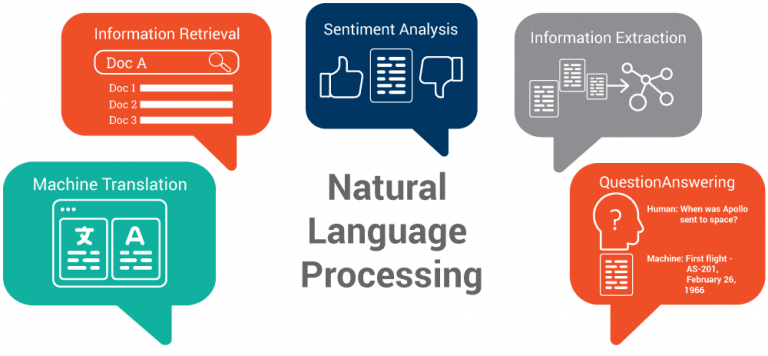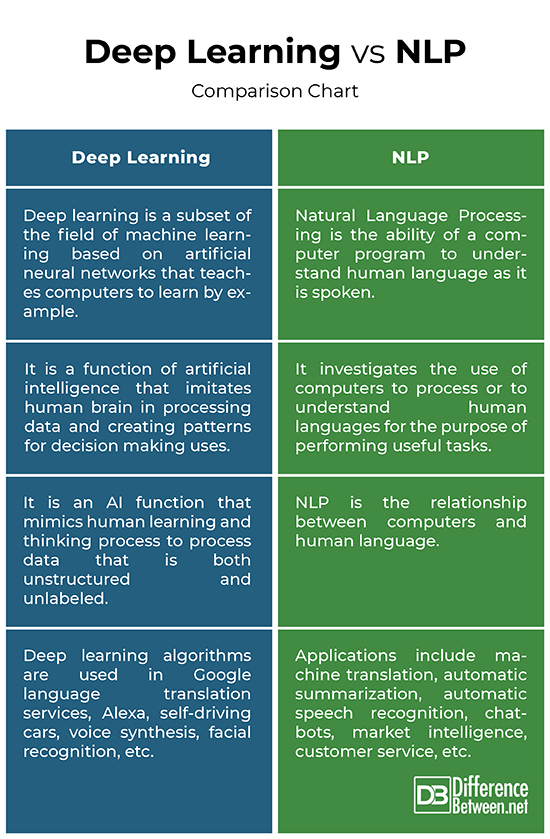Difference Between Deep Learning and NLP
Deep Learning Vs. Natural Language Processing (NLP)
Deep learning and NLP are some of the hottest buzzwords around today. NLP, short for Natural Language Processing, is one of the prominent technologies of the information age and like most of the great ideas, the concepts of NLP have been embraced by many leaders in their fields. It is basically a subfield of artificial intelligence that deals with interactions between computer and human languages. It is a revolutionary study of the process of human thought. Simply put, NLP is the study of what’s actually going on when we think. NLP started at the University of California, Santa Cruz in the early 1970s but has grown rapidly since then. Deep Learning, on the other hand, is a subset of the field of machine learning based on artificial neural networks. It is a technique of machine learning that teaches computers to learn by imitating human brain.

What is Deep Learning?
Deep learning has revolutionized computer vision and natural language processing, but what exactly is deep learning? Deep learning is a much broader concept that has changed forms slowly over the past decade. Deep learning uses artificial neural networks, which are designed to imitate human learning and thinking process. While it is true that deep learning is highly influenced by human brain, it should not be viewed as an attempt to simulate the brain. In fact, modern deep learning draws inspiration from many fields, especially applied math fundamentals like linear algebra, probability, information theory, and numerical optimization. Deep learning involves a network in which artificial neurons (typically thousands, millions, or probably more of them) are stacked at least several layers deep. One definition specifies that deep learning deals with a neural network with more than two layers.

What is Natural Language Processing?
Natural language processing is a set of methods for making human language accessible to computers. NLP is based on the theory that all human thinking occurs around five senses: picture, sound, feeling, smell, and/or taste. It is an integral part of artificial intelligence that aims to model the cognitive mechanisms underlying the understanding and production of human languages. NLP investigates the use of computers to process or to understand human languages for the purpose of performing useful tasks. It’s a basic means of communication. In today’s digital era, we tend to comprehend language scientifically because we try to make inanimate objects understand us. Thus, it has become essential to develop mechanisms by which language can be fed to inanimate objects such as computers. NLP helps with the same. In simple terms, NLP is a technology that aids computers to understand human language.
Difference between Deep Learning and NLP
Definition
– Deep learning is a subset of the field of machine learning based on artificial neural networks that teaches computers to learn by example. It is a function of artificial intelligence that imitates human brain in processing data and creating patterns for decision making uses. Natural language processing (NLP), on the other hand, is a set of methods to make human language accessible to computers. It investigates the use of computers to process or to understand human languages for the purpose of performing useful tasks. NLP is the ability of a computer program to understand human language as it is spoken.
Function
– Deep learning provides a powerful framework for supervised learning. By adding more layers and more units within a layer, a deep network can represent functions of increasing complexity. It is an AI function that mimics human learning and thinking process to process data that is both unstructured and unlabeled. NLP is the relationship between computers and human language. It investigates the use of computers to process or to understand human languages for the purpose of performing useful tasks. The idea is to read, decipher and understand the human languages in a manner that is valuable.
Applications
– NLP can be used in multiple ways when it comes to text classification and categorization. Text classification helps in many applications such as information filtering, web searching, readability assessment, and sentiment analysis. Other applications include machine translation, automatic summarization, automatic speech recognition, chatbots, market intelligence, customer service, etc. Deep learning algorithms are used in Google language translation services, Alexa, and self-driving cars. Other areas that are heavily dependent on deep learning are drug discovery, voice synthesis, and facial identification and recognition.
Deep Learning vs. NLP: Comparison Chart

Summary of Deep Learning vs. NLP
Deep learning is a set of methods based on artificial neural networks that resemble the human brain, which allow computers to learn from data without human supervision and intervention. Furthermore, these methods can adapt to changing environments and provide continuous improvement to learned abilities. Natural Language Processing is one of the prominent technologies of the information age and a subfield of artificial intelligence that deals with interactions between computer and human languages. NLP is the ability of a computer program to understand human language as it is spoken.
- Difference Between Caucus and Primary - June 18, 2024
- Difference Between PPO and POS - May 30, 2024
- Difference Between RFID and NFC - May 28, 2024
Search DifferenceBetween.net :
Leave a Response
References :
[0]Eisenstein, Jacob. Introduction to Natural Language Processing. Cambridge, Massachusetts: MIT Press, 2019. Print
[1]Patterson, Josh and Adam Gibson. Deep Learning: A Practitioner's Approach. Sebastopol, California: O'Reilly Media, 2017. Print
[2]Vieira, Armando and Bernardete Ribeiro. Introduction to Deep Learning Business Applications for Developers. New York: Apress, 2018. Print
[3]Image credit: https://miro.medium.com/max/768/0*yuoxwquAlbuEuhoU.png
[4]Image credit: https://thumbor.forbes.com/thumbor/960x0/https%3A%2F%2Fblogs-images.forbes.com%2Fbernardmarr%2Ffiles%2F2018%2F10%2FAdobeStock_179912599-1-1200x797.jpg
